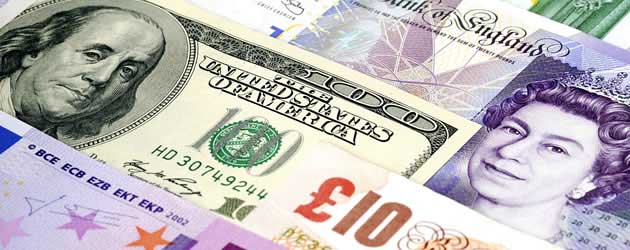
Sterling touched a 2.5-month high of 1.5732 against the US Dollar yesterday as investors continued to mull over Friday’s disappointing US Non-farm Payrolls report.
The Pound to US Dollar exchange rate (GBP/USD) began the week where it left off, advancing by around 0.7 cents thanks to momentum gained from last week’s terrific trio of PMI results. Manufacturing struck a 2-year high, Construction rose to a near-6-year high and the all-important Service Sector touched a peak not seen since December 2006.
Other factors such as upwardly revised Japanese GDP and better-than-expected Chinese trade numbers also damaged demand for the US Dollar as enhanced risk sentiment worked against the safe haven ‘Buck’.
With US Non-farms printing at 169,000, instead of the 180,000 that had been forecast, GBP/USD came within 20 pips of a fresh 7-month high. However, as Sterling battled with resistance levels, the US Dollar managed to establish itself below 1.5700 in reaction to a fairly innocuous speech from San Francisco Fed President John Williams. The Fed policymaker said that he “100%” agrees with Federal Reserve’s plan to taper asset purchases slowly before the end of the year and bring them to a halt at some point in 2014. However, Williams stated that he had not made up his mind yet with regards to whether or not to slowdown QE3 as early as this month.
The Fed is due to meet next week to discuss the implications of the so-called “Septaper”. The general view among market-players is that A) the US Central Bank will elect to taper asset purchases in September to preserve its credibility after months of variegated hinting and B) the taper will involve a relatively small reduction, possibly just $10-15 billlion, in light of last Friday’s NFP report and other soft US ecostats. This scenario should prove supportive of Sterling strength because it is practically priced into cable already and therefore should not lend the US Dollar any fresh encouragement.
In other US economic news it was reported that Consumer Credit increased by $10.4 billion in July to a seasonally adjusted annual total of $2.85 trillion. The result did little to boost the US Dollar because it was slightly below the market forecast of a $12.7 billion rise. The report showed that Americans were eager to take out loans for car purchases but less keen to spend money on credit cards. The second month of falling credit card receipts suggests that higher market interest rates could have deterred consumers from spending beyond their means.
Sterling fell by around -0.3 cents to 1.1840 against the Euro yesterday as Eurozone Investor Confidence rose to a 2-year high of +6.5 in September. The jump from -4.9 in August to +6.5 in September was the second largest rise since the survey began in 2003. The encouraging uptick in investors’ outlook comes as the currency bloc emerges from a six-quarter-long recession. However, it is still likely that the Pound to Euro exchange rate could mount a rally towards another fresh 7.5-month high above 1.1914 during the next few weeks.

Comments are closed.